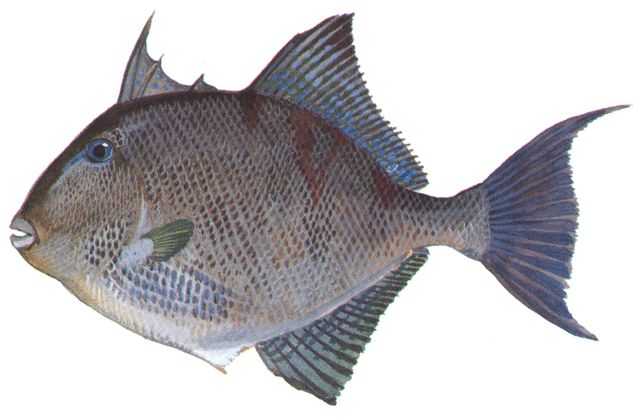Ocean Triggerfish

Species Details
Canthidermis Sufflamen
Balistidae
Tetraodontiformes
Offshore, Reef
4 - 13 lbs.
10" - 26"
Ocean Triggerfish (Canthidermis sufflamen) Fish Description
Ocean triggerfish are light grey or brownish-gray in color and have dense, oblong bodies that elongate as they mature. Their heads are pointed with a rounded snout and small mouth with large teeth. These species of triggerfish are fully-scaled with firm, tough skin with a lateral line that is barely visible and may be confused with the gray triggerfish by an inexperienced angler.
They have a distinct dark spot at the base of their pectoral fins. Their long, soft dorsal and anal fins gradually increase in height, with the longest ones nearly as large as its head.
The first dorsal fin has 3 spines that can be held in place, and the second dorsal has about 26 to 27 rays.
Diet and Size
The ocean triggerfish feed on crustaceans, invertebrates, zooplankton, and even sea urchins. Although they tend to live solitary, this fish may form loose schools at depths between 35 to 100 feet above reefs or near drop-offs of seaward reefs.
The ocean triggerfish are small fish between 10 and 18 inches in length but can grow as long as two feet. Their size makes them easy prey for larger fish such as yellowfin tuna. The International Game Fish Association world record for ocean triggerfish stands at 13 lbs 8 oz.
Interesting facts about the Ocean Triggerfish
- When threatened, ocean triggerfish will dive into a structure for shelter and stiffen the first spine on its dorsal fin to anchor itself to safety.
- The erect spine will not “unlock” unless the second dorsal fin is “triggered”, as a key to a lock.
- Triggerfish are infamous for charging at any intruders to their nests
- They hunt by beating away debris with their fins and squirting water and sand from their mouths
- In contrast to the other fish in their category, which are usually brightly-colored like the queen triggerfish, the ocean triggerfish is a duller color
Habitat and Distribution
The ocean triggerfish inhabits all Mexican waters of the Atlantic Ocean including the Gulf of Mexico and the Caribbean. They can be found from Canada to Massachusetts, Bermuda, the Bahamas, and South America in the western Atlantic. On the eastern side, they inhabit the islands of St. Paul’s Rocks, Ascension, Cape Verde, and St. Helena.
This fish is pelagic and may frequent algae beds of Sargassum, which are between 20 to 240 feet deep. The ocean triggerfish are common near drop-offs or steep walls of seaward reefs, or adjacent to reefs. These fish are usually offshore in depths of up to 195 feet but may thrive in shallower water as well. While generally not a gregarious fish, they may school with up to fifty individuals in open water.
When spawning, one male will congregate with multiple females, reaching up to six at a time. Males will protect the nest until the females deposit their eggs for fertilization, which occurs multiple times throughout the year. Both parents will defend the eggs from predators.
Fishing Techniques: How To Catch Ocean Triggerfish
The small mouths and sharp teeth of ocean triggerfish can be a fishing challenge for anglers, but with the right preparation, this gamefish is quite easy to catch.
To compensate for their small mouths, use small and sharp circle number four or number six hooks and small pieces of bait about the size of a small coin. Use a 15-pound test line with no leader and tie your hook directly.
Any live bait will be taken by the ocean triggerfish, although squid sliced into strips is often preferred since it sticks to the hook better. Triggerfish often nip at that bait first before taking it in, so having strips will give the bait some leeway before hooking.
Since ocean triggerfish are reef-dwellers, they can also be found in artificial structures, such as wrecks or flotsam. When fishing inshore, you will be able to spot them from the surface, and you can stealthily get within casting range easily. When within the right distance, cast your bait nearby and not on top of them, as they may get startled and swim away.
In deeper waters or when around reefs, you can drop a top-and-bottom rig with small hooks and baits. When the rig hits the bed, slowly reel it in, and don’t yank the line up if you want them to bite. You’ll need to use a six to eight-ounce sinker for deeper waters.





